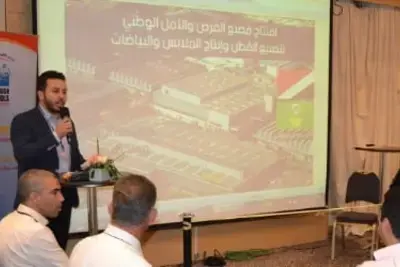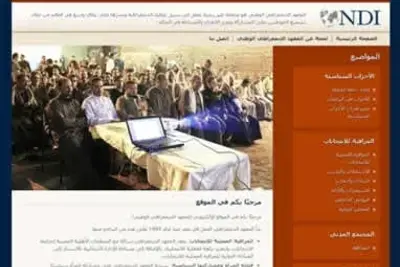Success Story
Civic Education and Constitutional Monitoring in Egypt
After the fall of the Mubarak government in Egypt and rapid changes in the political environment brought on by the Arab Spring, opportunities increased for organized and meaningful citizen participation. Likewise, the need to help citizens organize and engage also grew more apparent.
Anticipating parliamentary and presidential elections, NDI identified a widespread need for voter information and education. And it provided technical support to the Partners in Change coalition (PIC) to launch the Ally Sotak (“Raise Your Voice”) voter education and information campaign in October 2011. Ally Sotak is a collaborative partnership with PIC and a coalition of approximately 44 other Egyptian civil society organizations that individually advocate on a wide range of issues from human rights to care for the disabled.
The campaign provided voters with basic information about their rights and responsibilities in preparation for November 2011 parliamentary elections, including how to register and where to vote, as well as basic information about their electoral choices. With NDI guidance, the group developed a multi-faceted campaign plan that included creation of a website and a social media presence. The plan also highlighted the need to engage young people and took into account the short electoral time frames and lack of experience among Egyptian voters, civic activists and politicians alike.
To deal with some of these challenges, the coalition determined that the campaign required an online presence to quickly reach a large number of young people who frequently used the Internet and social media. NDI provided expertise to the group on how to develop its online profile, which became a centerpiece of the overall effort. While the campaign also used traditional media outlets, such as TV and radio, to reach segments of the population with less familiarity or access to the Internet, its integrated use of information and communications technology and targeting of young people set the campaign apart.
The campaign’s website became a central organizing tool that established uniformity in messaging and information for a quickly organized, countrywide campaign. Because Ally Sotak provided citizens with detailed information on a variety of topics related to the elections, including voter registration, accepted forms of ID and where to vote, creating the website was instrumental in offering a one-stop resource where all this information could be found.
The campaign was therefore able to organize volunteers on the ground, and used social media and advertising to direct people to the website. This eliminated the need for extensive training of volunteers on the information itself, allowing Ally Sotak to expand rapidly without compromising accuracy or comprehensiveness.
The campaign employed a strategic approach in incorporating social media tools, which included a detailed analysis of existing online information and resources, as well as the needs and location of the target audience that varied with respect to different aspects of the election. The coalition used its social media analysis to create online content that resonated with the target audience. Using data from Facebook, the campaign consistently tracked citizens’ engagement with the social media aspects of the campaign to ensure that the content and online dialogue fostered by the campaign continued to be engage and resonate with its audience.
The Ally Sotak campaign also encouraged citizens, especially young people, to take a more active approach to acquiring information and developing a deeper understanding of the election process. For example, the campaign used the website and social media to advertise ‘candidate fairs’, public events where candidates and political parties interacted with voters. In turn, Ally Sotak would set up a booth where volunteers provided nonpartisan information to citizens, and directed them to the campaign website and social media.
Ally Sotak’s ability to maintain political neutrality and provide nonpartisan information on the elections proved critical to the overall success of the program, and helped set the stage for future actions. The campaign’s wide reach and the neutral message significantly enhanced credibility and created a trusted brand, according to coalition members and NDI staff. The coalition used the same approach in the lead up to the June 2012 presidential election.
Building on the credibility established during the November 2011 and June 2012 elections, Ally Sotak partnered with the Egyptian Constituent Assembly, the body charged with drafting the new constitution and comprising representatives from major political parties. Ally Sotak worked with the assembly to increase citizen input in the drafting process by providing space online to post, comment and vote on proposed provisions, ranking them by popularity. The campaign complemented the online work with door-to-door campaigns, public events and campaign volunteers stationed on public transportation to collect citizen input. As in previous efforts, the offline campaign referred citizens to the website as a source for more information on the constitutional referendum. The Constituent Assembly discussed 100 of these suggestions, eventually adopting 34 for the constitution.
Overall, the successes of the Ally Sotak coalition provided an example of how the strategic use of social media can assist in outreach to specific target populations, in this case youth. It also demonstrated the importance of ongoing monitoring of social media engagement to ensure content continues to resonate with target audiences. Additionally, the coalition’s combination of online and offline approaches showed how websites and social media could lay the foundations for rapid scaling-up of information campaigns to respond to time-sensitive opportunities while maintaining consistency of message. This approach enabled Ally Sotak to use the opportunity of elections to provide for structured and organized engagement after the demonstrations at Tahrir Square, and to begin building a sustainable form of citizen organizing.
Published June 3, 2013



